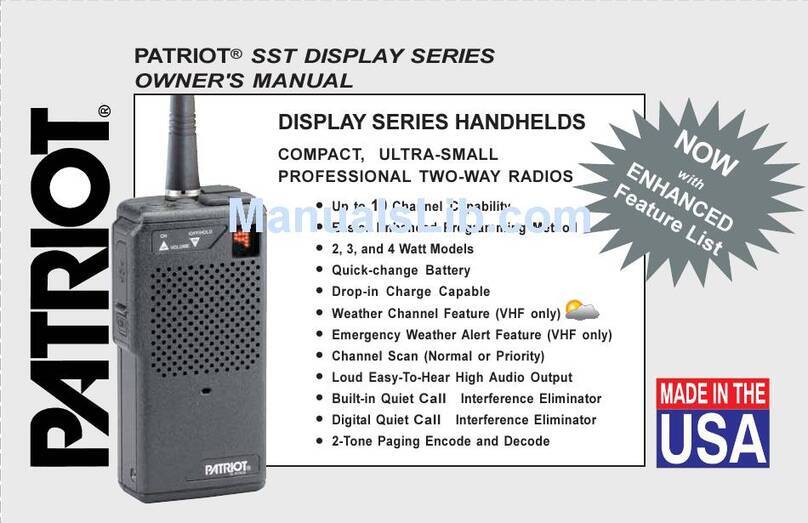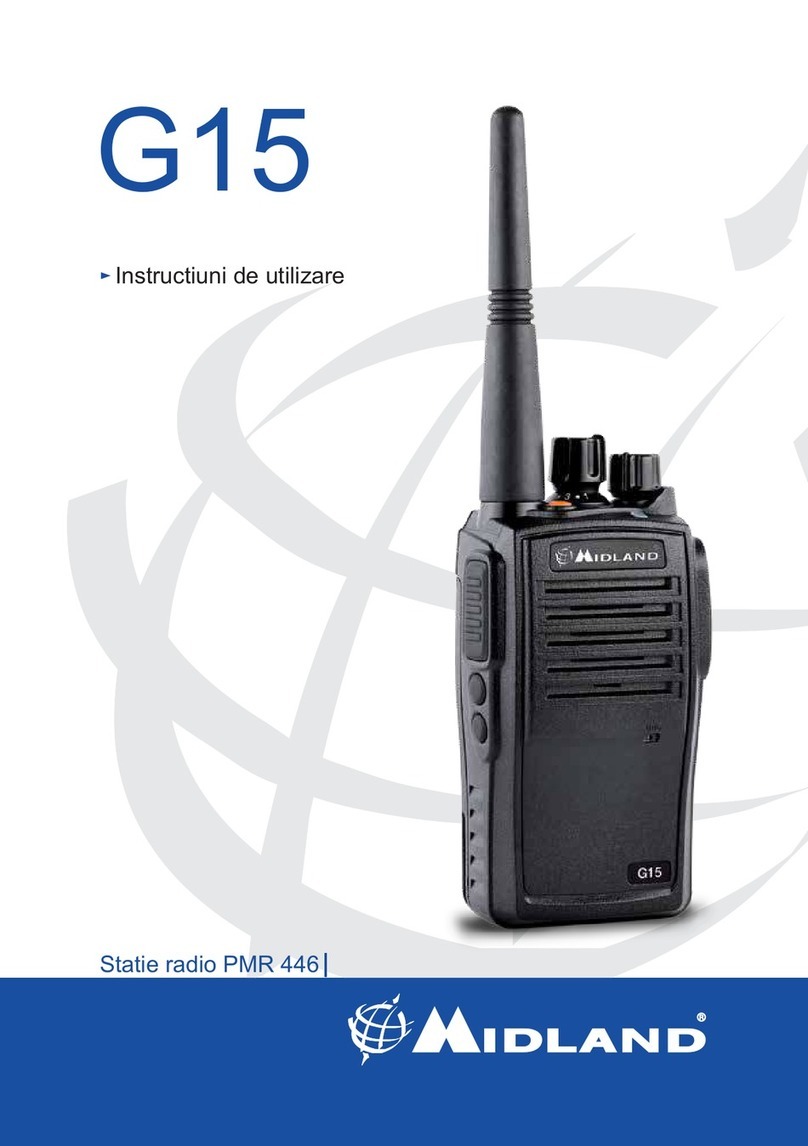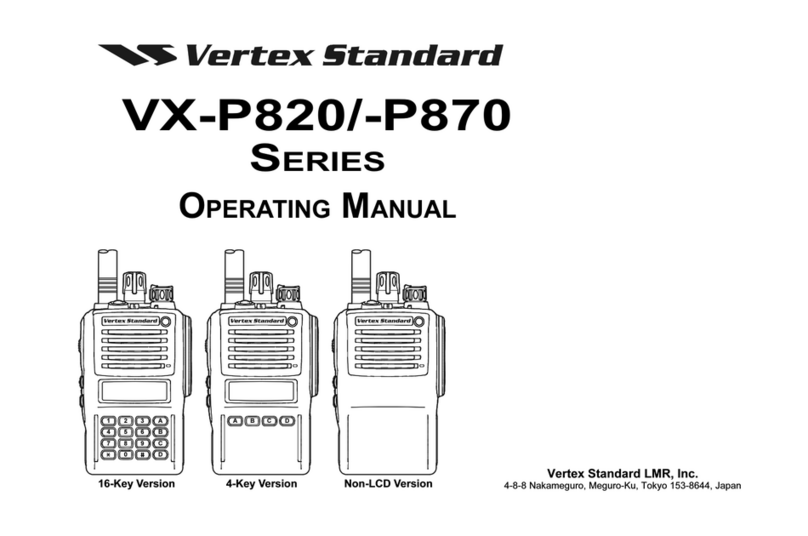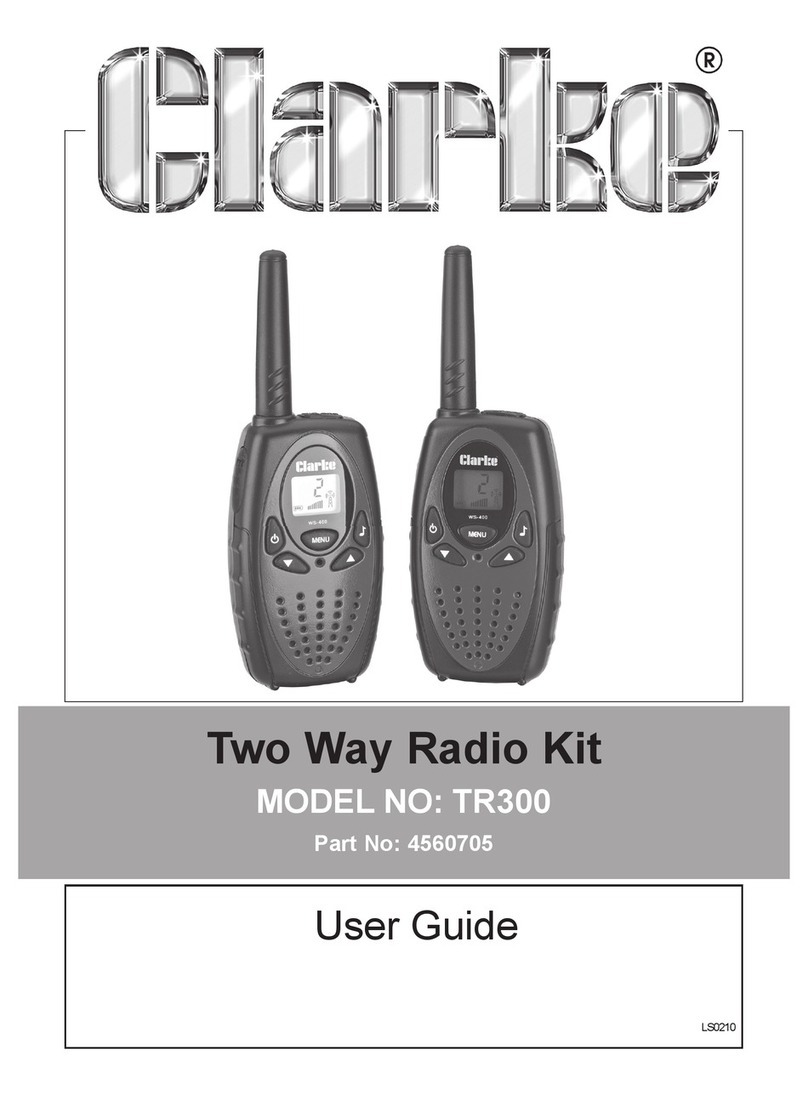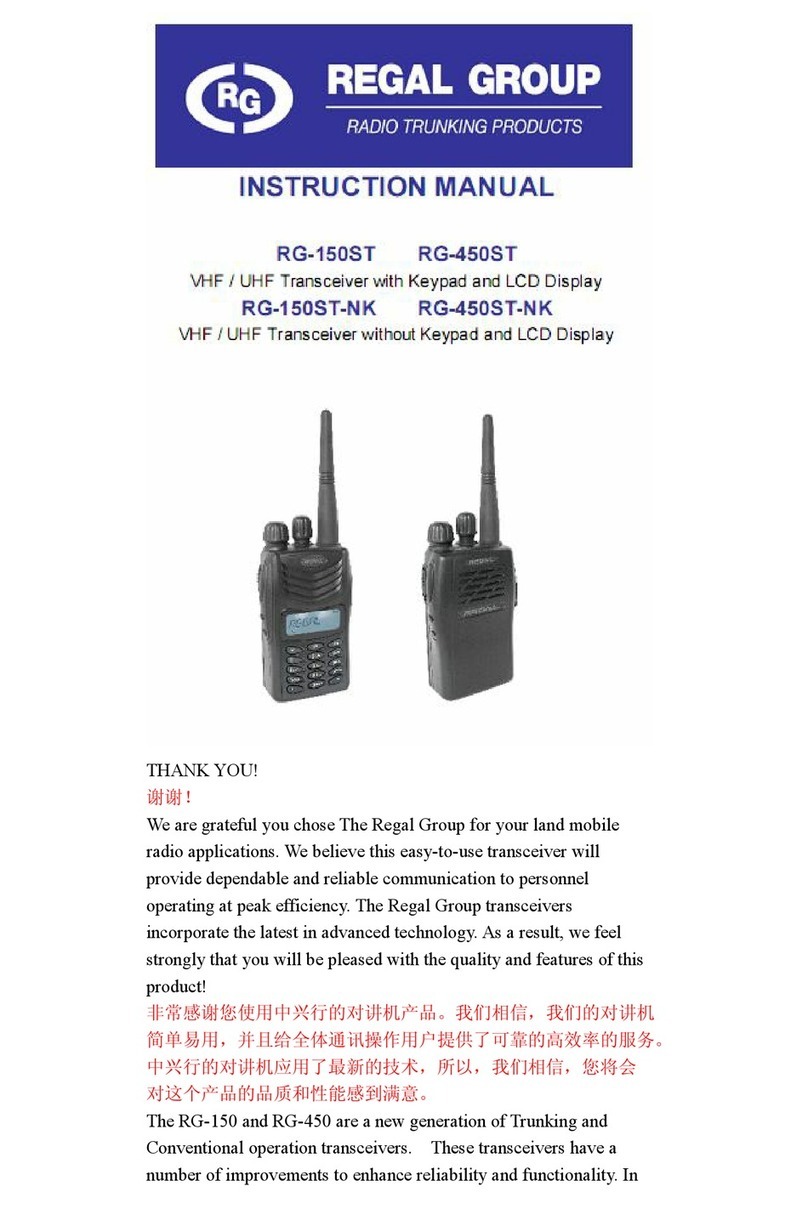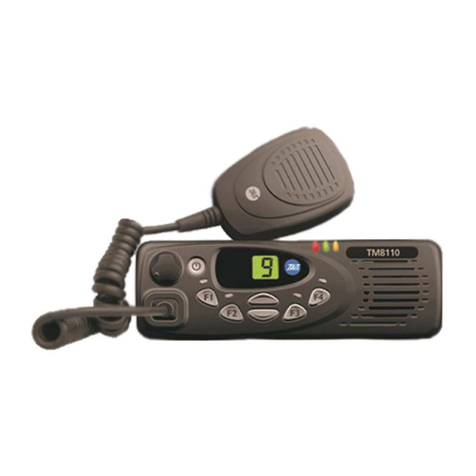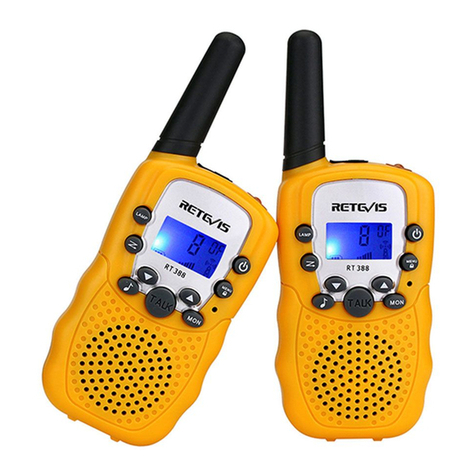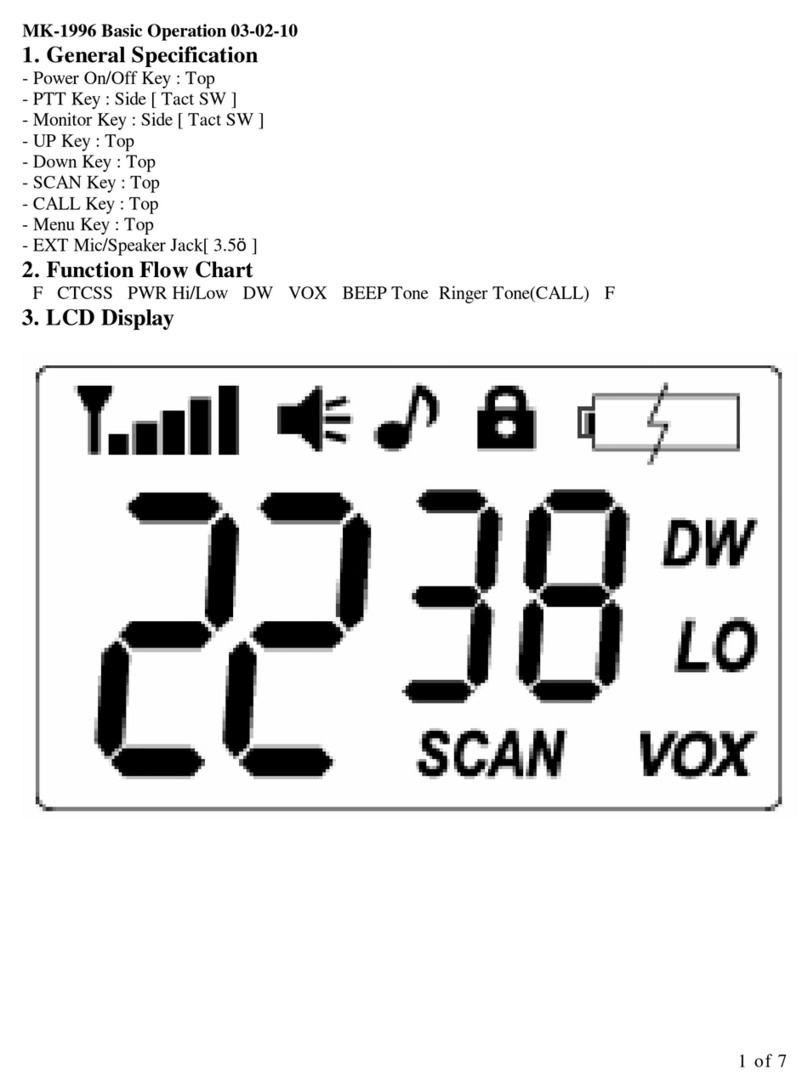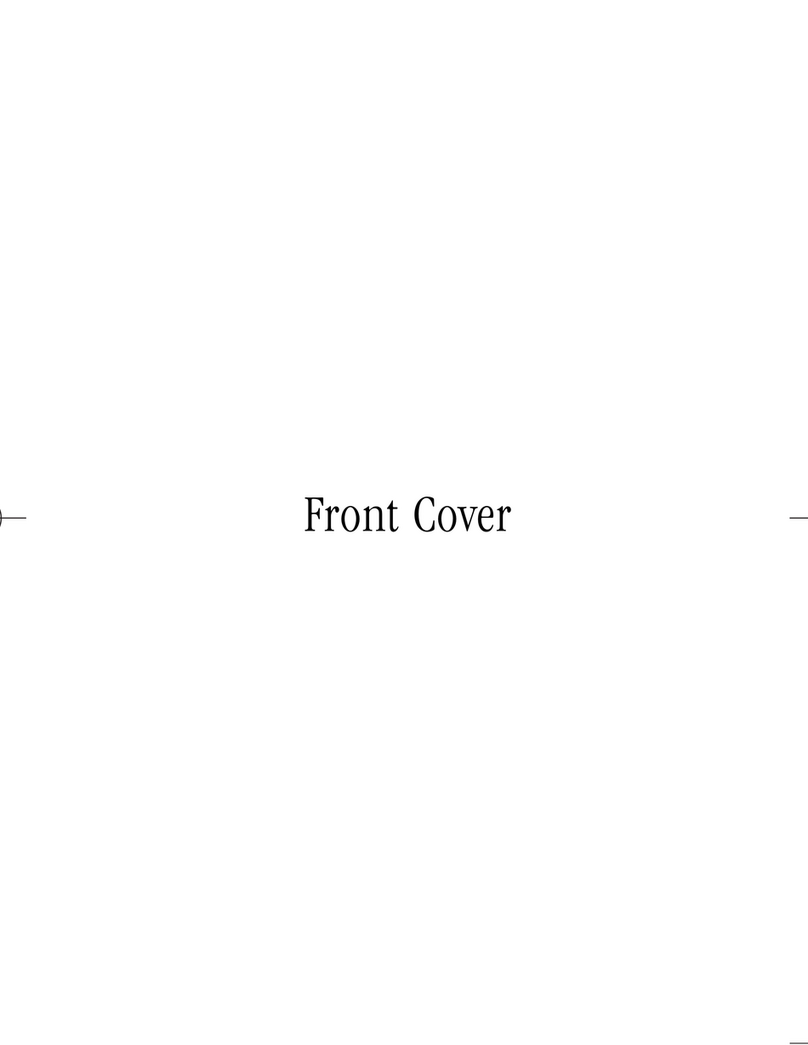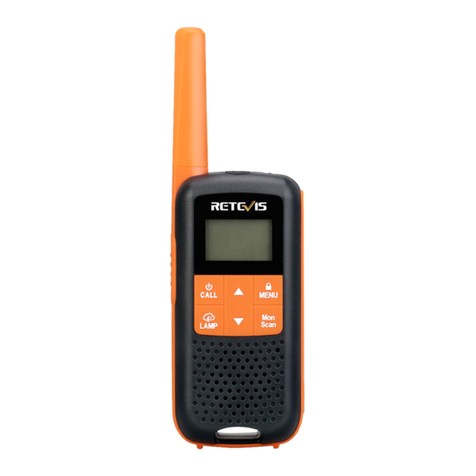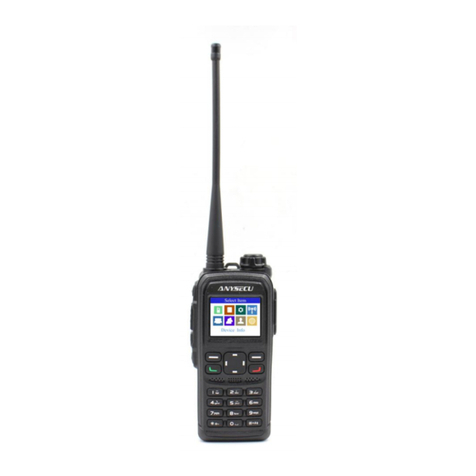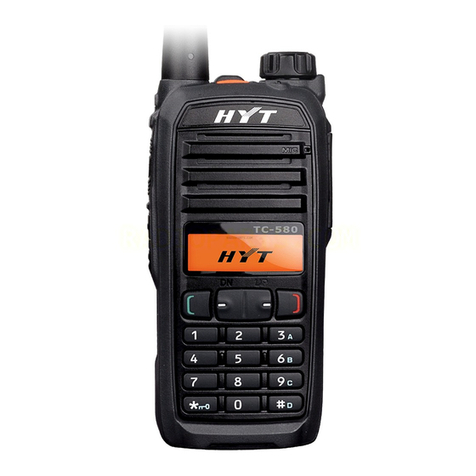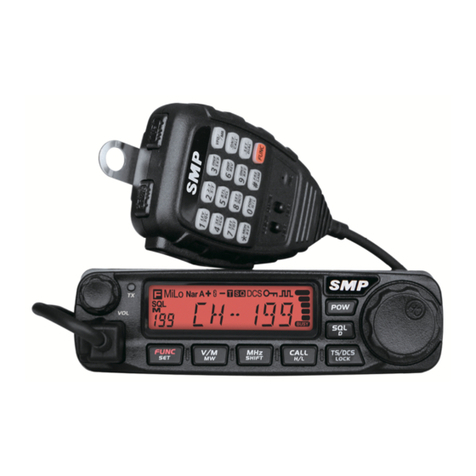Patriot RPM Series User manual

RPM SERIES
FM MOBILE RADIO
USER MANUAL
Pub. No. 01451181 Rev.D 09
-
02
Copyright© 2002 RITRON, INC.. ALL RIGHTS RESERVED.
RITRON, RPM, a d Quiet Call are registered trademarks of RITRON, INC.
Digital Quiet Call a d Pagi g Quiet Call are trademarks of RITRON, INC.
TWO-WAY RADIO
®
IMPORTANT
DETACH AND MAIL
----------------------------------------------------------------------------------------------------------------------------------
------------------------------------------------------------------------------------------
Tear along perforated line and mail your warranty registration card
RITRON, INC.
Attn: Warranty Department
P. O. Box 1998
Carmel, IN 46082 1998
Place
1st Class
Stamp
Here

Please read these sections first - FCC REGULATIONS, SAFETY PRECAUTIONS
INTRODUCTION
INSPECTION
1
MODEL IDENTIFICATION
1
RPM-150 and RPM-450
RPM-050
OWNER INFORMATION
*
FCC REGULATIONS
2
Licensing
Safety Standards
*
SAFETY PRECAUTIONS
3
Radio Mounting Location
Vehicle Operation
RADIO CARE
4
General
Service
STANDARD FEATURES
5
ACCESSORIES
6
RADIO CONTROLS - GENERAL
7
OPERATION
WHAT THE RADIO TONES MEAN
10
Power On/Self Check "OK"
Error Tones
CHANNEL SELECTION
10
OPERATING MODES
11
Receive
Transmit
PROGRAMMABLE OPTIONS
14
Quiet Call Code Signaling
Scanning (Normal/Priority)
Special Features
Customized Operation
WRITE DOWN YOUR CHANNEL CONTENTS
18
TROUBLESHOOTING
19
CHANNEL CONTENTS WORK SHEET
24
RITRON INC. LIMITED WARRANTY
22
CONTENTS
page ii
------------------------------------------------------------------------------------------
--------------------------------------------------------------------------------------------------------------------------------
Tear along perforated line and mail your warranty registration card
IMPORTANT
DETACH AND MAIL
WARRANTY REGISTRATION CARD
Company Name Contact Name
Street Address
City State Zip
Phone No. - - Fax No. - -
Email Radio Model No.
Place of Purchase Purchase Price
OUR Construction urs ry
APPLICATION: Electrical Contractor Warehouse
Sound/Security School
Manufacturing Lodging/Hot l
Farming Apartment/Condo Mgmt
Wire/Cable Contractor Retail
Hardware Other
Is this your first purchase of FM 2-way radios? s o
If no, is this purchase an: Add-on Replacement
If add-on or replacement, please specify existing brand(s); list all:
®

page 24
RITRON MODEL: SERIAL NUMBER:
CHAN
0
1
2
3
4
5
6
7
8
9
A
b
c
d
E
F
RECEIVE (RX)
FREQUENCY TRANSMIT (TX)
FREQUENCY QC
CODE
RX/TX
PQC
CODE
RX/TX
DQC
CODE
RX/TX
SCAN LIST (Add a "P" for Priority, "N" for Normal)
-OR- SPECIAL FEATURES
The RITRON RPM mobile is a programmable, track-tuned two-way radio that
can transmit and receive on any one of up to 16 channels in a professional FM
communications band (UHF or VHF available) This radio features channel select
and monitor push-buttons, and a single digit display Each channel can be "dealer
or factory" programmed to contain a unique set of operating frequencies and
options These options include communications industry standard signaling
formats: Quiet Call, Digital Quiet Call and Paging Quiet Call
INSPECTION
Make sure the radio package includes a RITRON mobile transceiver and two
boxes One box contains the microphone and attached cord The other box holds
radio and microphone brackets, a DC power cable, an in-line fuse assembly and
installation hardware See the installation instructions in the hardware box for a
complete list of parts included Examine the equipment immediately after delivery
and report any damages to the shipping company
MODEL IDENTIFICATION
RPM-150 AND RPM-450
A label attached to the back of the mobile includes the FCC identification and radio
serial numbers The radio model is the last six characters of the FCC ID number
For example, look at the label below The model number is RPM-450 This means
that the radio is designed to operate in the UHF FM band, on frequencies from
450 to 470 MHz A FCC label that says "RPM-150" identifies the radio as VHF,
for use on frequencies from 150 to 165 MHz (Models that operate in other sub-
bands within the UHF and VHF bands are available )
INTRODUCTION
page 1
FIG-1: RPM-450 FCC LABEL
Model No.
27500

page 23
RITRON, INC. LIMITED WARRANTY
(WARRANTY CONTINUED FROM THE PREVIOUS PAGE)
Some states do not allow the exclusion or limitation of incidental or consequential
damages, or limitation on how long an implied warranty lasts, so the above
limitations or exclusions may not apply to you. Because each covered product
system is unique, RITR N disclaims liability for range, coverage, or operation of the
system as a whole under this warranty.
WHO IS COVERED B THIS WARRANT
This warranty is given only to the purchaser or lessee of covered products when acquired
for use, not resale. This warranty is not assignable or transferable.
HOW TO GET WARRANT SERVICE
To receive warranty service, you MUST deliver or send the defective product, delivery
costs and insurance prepaid, within the applicable warranty period, to RITRO , I C., 505
West Carmel Drive, Carmel, Indiana 46032, Attention: Warranty Department. Please
point out the nature of the defect in as much detail as you can. You MUST retain your
sales or lease receipt (or other written evidence of the date of purchase) and deliver
it along with the product. If RITRO chooses to repair or replace a defective product,
RITRO may replace the product or any part or component with reconditioned product,
parts or components. Replacements are covered for the balance of the original
applicable warranty period. All replaced covered products, parts or components become
RITRO 's property.
RIGHTS TO SOFTWARE RETAINED
Title and all rights or licenses to patents, copyrights, trademarks and trade secrets in any
RITRO software contained in covered products are and shall remain in RITRO .
RITRO nevertheless grants you a limited non-exclusive, transferable right to use the
RITRO software only in conjunction with covered products. o other license or right
to the RITRO software is granted or permitted.
OUR RIGHTS UNDER STATE LAW
This warranty gives you specific legal rights, and you may also have other rights
which vary from state to state.
WHERE THIS WARRANT IS VALID
This warranty is valid only within the United States, the District of Columbia and Puerto
Rico.
RPM-050
Refer to FIG-2. For RPM-050 units, the model number appears below the FCC
identifi ation number. There are two separate RPM-050 models available. One is
RPM-050-M, designed for operation in the 30 to 38 MHz sub-band. The other is
RPM-050-N, for use on frequen ies from 38 to 50 MHz.
FCC REGULATIONS
LICENSING
The FCC requires you to obtain a station li ense for your radios before using the
equipment to transmit, but does not require an operating li ense or permit. The
station li ensee is responsible for ensuring that transmitter power, frequen y and
deviation are within the limits spe ified by the station li ense.
The station li ensee is also responsible for proper operation and maintenan e of his
radio equipment. This in ludes he king the transmitter frequen y and deviation
periodi ally, using appropriate methods.
Your RITRON dealer an help you obtain a FCC li ense. To re eive a FCC li ense
for VHF or UHF frequen ies, you must submit FCC appli ation Form 574.
SAFETY STANDARDS
The FCC (with its a tion in General Do ket 79-144, Mar h 13, 1986) has adopted
a safety standard for human exposure to radio frequen y ele tromagneti energy
emitted by FCC regulated equipment.
page 2
INTRODUCTION/OWNER INFORMATION
FIG-2: RPM-050 FCC LABEL
14265

page 22
RITRON, INC. LIMITED WARRANTY
WHAT THIS WARRANT COVERS
RITRON, INC. ("RITRON") provides the following warranty against defects in aterials
and/or work anship in RITRON Brand Mobile Radios and Accessories under
nor al use and service during the applicable warranty period (as stated below).
"Accessories" eans antennas, speakers, icrophones, and ite s contained in the
progra ing and installation kits.
WHAT IS COVERED FOR HOW LONG WHAT RITRON WILL DO
PATRIOT * 1 year During the first year after
Mobile Radios date of purchase, RITRON will
repair or replace the defective
product, at RITRON's option,
parts and labor included at no
charge.
Accessories * 90 days * After date of purchase
WHAT THIS WARRANT DOES NOT COVER
Any technical information provided with the covered product or any other products;
Installation, maintenance or service of the product, unless this is covered by a
separate written agreement with RITRO ;
Any products not furnished by RITRO which are attached or used with the covered
product, or defects or damage from the use of the covered product with equipment
that is not covered;
Defects or damage, including broken antennas or microphones, resulting from:
- misuse, abuse, improper maintenance, alteration, modification, neglect, accident or
act of God,
- the use of covered products other than in normal and customary manner or,
- improper testing or installation;
Defects or damages from unauthorized disassembly, repair or modification, or where
unauthorized disassembly, repair or modification prevents inspection and testing
necessary to validate warranty claims;
Defects or damages in which the serial number has been removed, altered or
defaced.
IMP RTANT: This warranty sets forth the full extent of RITRO 's express responsibilities
regarding the covered products, and is given in lieu of all other express warranties. What
RITRO has agreed to do above is your sole and exclusive remedy. o person is
authorized to make any other warranty to you on behalf of RITRO . Warranties implied
by state law, such as implied warranties of merchantability and fitness for a particular
purpose, are limited to the duration of this limited warranty as it applies to the covered
product. Incidental and consequential damages are not recoverable under this warranty
(this includes loss of use or time, inconvenience, business interruption, commercial loss,
lost profits or savings).
(WARRANTY CONTINUED ON THE NEXT PAGE)
OWNER INFORMATION
RITRON follows these safety standards, and re ommends that you observe the
following guidelines:
DO NOT operate a mobile radio transmitter when someone outside the vehi le
is within two feet of the antenna.
DO NOT transmit with a fixed radio (base station, mi rowave, rural telephone RF
equipment) or marine radio when someone is within two feet of the antenna.
DO NOT operate any radio transmitter unless all RF onne tors are se ure and
any open onne tors are properly terminated.
DO NOT operate radio equipment near ele tri al blasting aps or in an explosive
atmosphere.
GROUND ALL RADIO EQUIPMENT a ording to RITRONs installation sheet.
RITRON produ ts should be repaired only by RITRON authorized personnel.
SAFETY PRECAUTIONS
RADIO MOUNTING LOCATION
Consider driver and passenger safety when you hoose a lo ation for the radio.
Do not mount the unit overhead or on a sidewall unless you take spe ial pre autions,
su h as se uring the radio with a retaining strap.
Improper installation in reases the possibility that a ar a ident ould dislodge
the radio and make it a dangerous proje tile.
VEHICLE OPERATION
ELECTRONIC SYSTEMS
Che k the vehi le's manual for possible warnings about operating a two-way
radio in a vehi le equipped with an ele troni ignition or anti-skid braking system.
LIQUEFIED PETROLEUM (LP) GAS FUEL SYSTEM
Radio installation in a vehi le fueled by liquefied petroleum (LP) gas (with the LP
gas ontainer stored in a sealed-off spa e, su h as the trunk) must onform to
NFPA (National Fire Prote tion Asso iation) standard 58.
BATTERY POWER
Avoid leaving the radio turned on for long periods when the engine is off, whi h
ould run down the vehi les battery. page 3

page 21
Notes
1) Re eption an often be improved by moving a short distan e. The strength of a
radio broad ast and therefore its overage is de reased by distan e and
obstru tions (natural and man-made). This in ludes hills, valleys, foliage,
buildings, basements and other metal or on rete stru tures. The best range and
overage is obtained a ross flat terrain, with line-of-sight visibility and no
obstru tions.
2) If the radio speaker makes a ontinuous rushing noise, press and release the
monitor button to a tivate arrier squel h. Otherwise, this button toggles Quiet-
Call ( oded) squel h on and off.
If pressing and releasing this button does not toggle Quiet Call squel h on and
off, the radio has been dealer or fa tory programmed for optional monitor
operation. In this ase, pressing and holding the monitor button will turn off
Quiet Call squel h and allow you to monitor the hannel. Quiet Call squel h
automati ally resumes when you release the monitor button.
3) If you want to hear a all, you must sele t a hannel that is programmed to re eive
the aller's transmit frequen y. If you want to all another unit, you must sele t
a hannel that is programmed to transmit the other radio's re eive frequen y.
However, if you use a repeater, your hannel must be programmed to work with
the repeater's transmit and re eive frequen ies. (A hannel an hold two
separate radio frequen ies, one for re eive, the other for transmit.)
4) If you get repeating error tones when you press the PTT, the hannel might be
programmed for "Re eive Only." If so, the hannel does not ontain a transmit
frequen y, and annot be used to transmit. Repeating tones will sound if the
Busy Channel Transmit Inhibit feature is a tivated and another user's radio
signal is present on the hannel.
5) In order for radios to ommuni ate using Quiet Call, they must be programmed
with the same Quiet Call ode. Ea h ode is unique, and your radio will respond
only to the ode programmed for the hannel sele ted. Note that a hannel
may have been programmed to transmit one ode, and re eive (dete t) another
ode.
TROUBLESHOOTING
RADIO CARE
MOISTURE
The mobile is not waterproof and should not be exposed to rain, or immersed.
EXTREME HEAT
Like all ele troni equipment, the mobile should not be subje ted to extreme
heat, su h as being left to absorb dire t sunlight in a losed vehi le.
VIBRATIONS/SHOCKS
Although your RITRON mobile radio is designed to be rugged, it annot be
expe ted to survive abuse. Avoid dropping the radio.
CHEMICALS
Detergents, al ohol, aerosol sprays and/or petroleum produ ts might damage
the radio front panel and/or ase. Clean the mobiles exterior using a soft loth
moistened with water.
SERVICE
Federal law prohibits you from making any internal adjustments to the transmitter,
and from hanging transmit frequen ies unless you are spe ifi ally designated by
the li ensee.
If your radio equipment fails to operate properly, or you wish to have your mobile
programmed, onta t your authorized dealer or RITRONs Repair Department.
page 4
OWNER INFORMATION
RITRON, INC.
Repair Department
505 West Carmel Drive
Carmel, IN 46032 USA
Phone:317-846-1201
FAX:317-846-4978
Email: ritron@ritron. om

page 20
TROUBLESHOOTING
Problem Possible Solutions
QUIET CALL (QC, DQC AND PQC)
You annot s reen out alls from users Hang up the mi rophone.
outside of your Quiet Call group.
Toggle the monitor button to sele t
Quiet Call ( oded) squel h. (Note 2.)
Make sure that the hannel is pro-
grammed with Quiet Call.
You annot hear Quiet Call messages Confirm that the hannel is program-
while in Quiet Call ( oded) squel h. med to dete t the same ode as the
alling radio(s) transmits. (Note 5.)
Others in your Quiet Call group annot Verify that you transmit the same
hear your Quiet Call messages. ode as the radio(s) you all are
programmed to dete t. (Note 5.)
You annot turn off Quiet Call squel h If toggling the monitor button does
while the mi rophone is on-hook. not work, press and hold this button.
The way the monitor button works is
dealer-programmable. (Note 2.)
ALL-CALL PAGE (PAGING QUIET CALL)
You annot hear a Paging Quiet Call Make sure that the hannel is pro-
All-Call page while in oded squel h. grammed with a PQC ode.
Other PQC (Paging Quiet Call) units Confirm that the hannel sele ted
annot hear your All-Call page. when you send a page is programmed
with a PQC ode.
Make sure that you follow the All-Call
page instru tions on page 16.
16 RECEIVE/TRANSMIT CHANNELS
FEATURES PROGRAMMABLE ON A PER CHANNEL BASIS (BY YOUR
DEALER OR THE FACTORY):
Channel S anning (Normal/Priority)
Tone Coded Squel h (Quiet Call)
Digital Coded Squel h (Digital Quiet Call)
Paging De ode (Paging Quiet Call)
Transmitter Time-out Timer
Spe ial Features (in luding TX Busy and Monitor Lo k Out)
HIGH PERFORMANCE RECEIVER
LONG RANGE TRANSMITTER
EASY-TO-READ DIGITAL DISPLAY
TRANSMIT/CHANNEL BUSY INDICATOR
ON-HOOK PUSH-BUTTON MONITORING
PUSH-BUTTON CHANNEL SELECTOR
ROTARY ON-OFF/VOLUME CONTROL
COMPACT SIZE (2 1/8" H X 5 3/4" W X 7 3/8" L)
RUGGED "UNI-BODY" ALUMINUM CASE
LOW DISTORTION MICROPHONE WITH COIL CORD
MODULAR MICROPHONE CONNECTOR
HIGH VOLUME FRONT-FACING SPEAKER
EXTERNAL SPEAKER JACK
RADIO MOUNTING BRACKET AND HARDWARE
MICROPHONE HANG-UP CLIP AND HARDWARE
+12 VDC POWER CABLE WITH IN-LINE FUSE
LIMITED ONE YEAR FACTORY WARRANTY
STANDARD FEATURES
page 5

page 19
TROUBLESHOOTING
If you have trouble operating the radio, review the radio ontrols and operation
se tions. If you think the unit is malfun tioning, he k the table below.
Problem Possible Solutions
GENERAL
Front panel lamps do not light. Repla e the DC power able fuse.
The DC able is not properly
onne ted. (Refer to the Mobile
Radio Installation Guide: RITRON
pub. no. 01454928.)
Re eption is poor. Move to a different lo ation.
(See note 1 on page 22.)
The antenna is installed in orre tly -
see the antenna installation guide.
The antenna is damaged.
Noise or "hiss" sounds in the radio. Press and release the monitor button.
(Note 2.)
You annot hear alls from other radios. Press and release the monitor button.
(Note 2.)
Be ertain that your radio re eives
on the same frequen y as the aller
transmits. (Note 3.)
Your alls annot be heard in other Make sure that your radio transmits
radios. on the re eive frequen y of the
radio(s) you want to all. (Note 3.)
ERROR TONES
An error tone sounds when the radio See page 11, "Error Tones."
is first swit hed on.
Repeating tones o ur when you press The hannel is "Re eive Only," or the
the PTT button. TX Inhibit feature is on. (Note 4.)
An error tone sounds while you are See page 11, "Error Tones."
talking (and the transmitter shuts off).
page 6
Several a essories appear below. Conta t your dealer or RITRON for other
available items.
ITEM NO. DESCRIPTION
RM-5TT Hand Mi rophone with 12-button Tou h Tone Keypad
RM-4 Hand Mi rophone, repla ement
RM-6 Desktop mi rophone
RSP-5 External Speaker with 10 ft. ord, 3.5 mm plug
OPT-TIR Trunking Interfa e Ready Option
RPM-150-M VHF Mobile Radio, 12.5 KHz synthesizer spa ing
RPM-450-A UHF Mobile Radio, operates on optional 470 to 490 MHz
sub-band
RPM-450-B UHF Mobile Radio, operates on optional 490 to 512 MHz
sub-band
RPMK-12 Installation Kit for RPM radio, In ludes:
1) 1 - Mobile radio mounting bra ket
2) 1 - 12 VDC power able with in-line fuse
3) 1 - Mi rophone hang-up lip
4) Hardware and installation instru tions
RPM-MRM-A RPM-150/450 Maintenan e/Repair/Operating Manual
RPM-MRM-050 RPM-050 Maintenan e/Repair/Operating Manual
Fa tory programming of hannels, odes and features is also available.
ACCESSORIES

page 18
SPECIAL FEATURES STANDARD SETTINGS
Unless progra ed otherwise, special features are as follows:
SPECIAL FEATURE STANDARD SETTING
Squelch Tightner Factor. . . . . . . . . . . . . . . . . . . . . Maxi u sensitivity
Channel Monitor Lock Out. . . . . . . . . . . . . . . . . . . Off
Busy Channel Trans it Inhibit . . . . . . . . . . . . . . . . Off
Reduced Trans it Power. . . . . . . . . . . . . . . . . . . . Off (Full power on)
Paging Quiet Call Transpond . . . . . . . . . . . . . . . . . Off
CUSTOMIZED OPERATION
Operating features ay have been factory or dealer custo ized as requested by the
radio owner, causing the radio to operate differently than outlined in this anual.
Consult your dealer about optional features.
WRITE DOWN YOUR CHANNEL CONTENTS
Use the work sheet on the back page of this anual to keep track of the channel
contents (operating frequencies, codes, etc.) progra ed for each channel. Only
authorized service/ aintenance personnel can deter ine channel contents. Your
dealer (or the licensee, if you don't own the radio) can provide this infor ation and
explain any special features progra ed.
OPERATION
ON-OFF/VOLUME CONTROL
The on-off/volu e control knob switches the unit on and off, and adjusts vol
CHANNEL DISPLAY
This digital display indicates the channel nu ber or scan list.
CHANNEL SELECT BUTTON
With the radio in operating ode, pressing and releasing the channel b
advances the display to the next progra ed channel. Holding down the cha
button while toggling the onitor button oves the channel display backwar
SPEAKER
An internal speaker is ounted behind the front panel. An external speaker a
plugged into the rear panel jack, which disconnects audio to the front speake
RADIO CONTROLS - GENERAL
page 7
FIG-3: FRONT PANEL
ON-OFF/Volume Control
Monitor Lamp
Channel Display Speaker
Monitor Button
Transmit/Busy Lamp
Channel Select Button

OPERATION
BUSY CHANNEL DELETE
If a channel in the scan list is so busy that you want to te porarily delete that
channel fro the list, press the onitor button while scanning is stopped on the
channel to be deleted. (The priority channel in a Priority Scan List is an exception,
and cannot be re oved.) The onitor status will not change. The deleted
channel will be skipped in the scan list until you switch channels. You ay delete
ore than one channel in the list.
SPECIAL FEATURES
RECEIVER SQUELCH TIGHTNER FACTOR
This feature reduces distant "co-channel" or other interference for channels
that are not progra ed with Quiet Call. Carrier squelch is set for axi u
sensitivity at the factory, but can be adjusted to ute weak radio signals.
CHANNEL MONITOR LOCK OUT
This function can be progra ed to prevent a radio user fro listening to other
licensees on a shared channel. The trans it/busy la p indicates whether the
channel is busy. Quiet Call or Digital Quiet Call ust be used with this option.
BUSY CHANNEL TRANSMIT INHIBIT
Busy Channel Trans it Inhibit keeps the radio fro broadcasting if the channel
is busy, and is often used with Channel Monitor Lock Out. If you press the
icrophone PTT while the channel is busy with a signal not intended for your
radio (not carrying your Quiet Call code), the Busy Channel Trans it Inhibit
feature sounds a "busy" tone in the speaker and keeps the trans itter off.
REDUCED TRANSMIT POWER
This feature allows for reduced trans itter power on individual channels, which
ight be required by so e FCC licenses.
PAGING QUIET-CALL TRANSPOND
If you receive a page and do not answer within three seconds, this feature
auto atically activates your radio's trans itter and sends an acknowledge-
ent tone to the calling party.
page 17
MONITOR BUTTON
For channels progra ed with Quiet Call, pressing and releasing the onitor
button toggles onitoring on and off. (The icrophone ust be on-hook.) Monitor-
ing lets you hear all radio traffic on the channel. With onitoring off, you hear only
radios that trans it your Quiet Call code. (If the onitor button does not work as
described here, refer to the onitor section on page 13.)
Pressing and holding the onitor button for about two seconds turns off all squelch.
Then ALL signals on the channel AND the noise between broadcasts is heard.
MONITOR LAMP (GREEN)
The onitor la p (see FIG-3 at left) lights when the unit is in onitor ode.
MICROPHONE HANG-UP
The icrophone hang-up controls squelch and onitor functions, through a hook-
switch circuit inside of the icrophone. The icrophone is ON-HOOK when it is
in its hang-up clip, as shown below. The icrophone is OFF-HOOK when it is out
of its hang-up clip.
page 8
RADIO CONTROLS - GENERAL
FIG-4: MICROPHONE ON-HOOK
Han -up
Clip
Push-To-Talk
Button

OPERATION
SCANNING (NORMAL/PRIORITY)
___________________________________________________________________________
HOW TO:
SCAN - hang up the microphone and select the channel that contains your scan list
STOP SCANNING - take the microphone off-hook or, change channels
___________________________________________________________________________
GENERAL
Scanning auto atically lets you listen to broadcasts on different radio channels
(frequencies). The channels to be scanned are kept in a "scan list." This list is
stored in a radio channel. A channel cannot hold both a scan list and a radio
frequency.
HOW SCANNING WORKS
When you select a channel that contains a scan list (and the icrophone is
on-hook), the radio displays the channel nu ber, pauses, sounds a tone, and
then scans, displaying each channel of the scan list in turn. Channels are
scanned in the order that they were progra ed into the list. When a broadcast
is received on a channel being scanned, scanning stops to let you hear co -
unications on that channel. Scanning resu es when the trans ission ends.
The icrophone ust be in its hang-up clip for scan to work. If you lift the
icrophone fro its hang-up clip OR press the channel button, scanning stops.
(Whether scanning stops on the last active channel or on the priority channel is
dealer-progra able.) If you select a channel that contains a scan list and the
icrophone is off-hook, the radio skips to the next channel.
Using the onitor button does not interrupt scanning. Additionally, if you take
the icrophone off-hook to stop scanning or to trans it, scanning resu es
when you return the icrophone to its clip.
If the radio is scanning and you want to know which channel received the last
broadcast, ove the channel selector slowly through the channels. When the
last active channel is selected, the radio e its a "triple beep."
PRIORITY SCANNING
Priority scanning lets you onitor other channels without issing a call on your
priority channel, which the radio periodically checks for activity even when
scanning has stopped on another channel. Priority scanning works only if the
scan list progra ed is a Priority Scan List, not a Nor al Scan List.
page 16
PUSH-TO-TALK
Pressing the icrophone Push-To-Talk (PTT) activates the radio trans itter.
Refer to FIG-4, page 9. Talk into the icrophone while holding down the PTT.
TX/BUSY LAMP (RED)
The trans it/busy la p flashes if the channel is in use, and stays lighted while the
trans itter is on.
MICROPHONE PLUG-IN
The icrophone cord is connected to the radio front panel via a odular plug. When
you insert the plug, align it as shown below. The cord ay be re oved by pressing
up on the underside of the rubber cover to unseat the plug's lock-tab. The cover is
attached to the plug and should not be pulled off.
RADIO CONTROLS - GENERAL
FIG-5: MICROPHONE PLUG-IN
page 9
Modular Plu
Lock-Tab
To Microphone
Modular Plu Cover
Lock-Tab at Bottom

OPERATION
DIGITAL QUIET CALL
Digital Quiet Call is RITRONs tradena e for digital coded squelch. DQC works
the sa e as QC, except that a digital code is applied to the broadcast. Radios
progra ed with the correct code "recognize" the inco ing broadcast and
allow the essage to be heard.
PAGING QUIET CALL
General
Paging Quiet Call (PQC) is RITRON's tradena e for its selective paging syste .
Each radio or group of radios ay have a unique PQC code. Any channel that
contains an operating frequency can be progra ed with one of these codes.
(A channel progra ed with PQC ay also contain a QC code.) With a PQC
channel selected and coded squelch on, the radio stays quiet until it receives the
correct PQC code. A ringing tone announces an inco ing call.
Each Paging Quiet Call code is broadcast as a unique pair of audible tones, with
the first tone sent for one second, and the second tone for two seconds. PQC
codes can be originated by a base station paging encoder, a telephone (via a
RITRON RR-454 Repeater Plus/RP-200 syste ), or a RPM obile equipped
with a Touch Tone hand icrophone.
The All-Call Code
Radios operated with PQC respond to a special All-Call code, as well as to their
individual codes. This allows one page to be heard by all "PQC units" on the
channel. The standard RPM obile radio can trans it an All-Call page.
__________________________________________________________________
HOW TO:
Send An All-Call Page -
1) Select a channel programmed with Paging Quiet Call
2) Turn off the radio
3) Press and hold the microphone PTT button while switching on the radio
Keep holding down the PTT A continuous tone will sound
4) Release the PTT when you hear alternating tones
5) Hold down the PTT again and deliver your message
__________________________________________________________________
page 15
WHAT THE RADIO TONES MEAN
The RITRON RPM obile responds to certain instructions by sounding a tone or
series of tones. These tones can tell you whether the radio is working as you expect.
POWER ON/SELF CHECK "OK"
Switch on the radio by rotating the on-off/volu e knob clockwise out of the "click"
position. The obile then runs a quick "self test." When the internal syste checks
verify basic operation, a brief tone sounds that eans the radio is ready to use.
ERROR TONES
However, if the self test detects a diagnostic error, an error tone sounds. One low-
pitched tone eans that the radio icrocontroller is not working as it should.
Alternating tones (the second is lower pitched) indicate that the radio frequency
synthesizer is alfunctioning. If you get one of these essages, turn off the radio
and try again. If the proble continues, consult an authorized RITRON service
facility or the RITRON Repair Depart ent.
Repeating error tones occur if you press the icrophone Push-To-Talk button while
a "Receive Only" channel is selected. The radio will not trans it because a "Receive
Only" channel does not contain a trans it frequency. The error tone repeats until
you release the PTT.
One low tone sounds and the trans itter auto atically shuts off if you hold the
PTT down continuously for a specified ti e (nor ally, 3 inutes). This trans itter
ti e-out feature ay be turned off or adjusted by authorized service personnel.
CHANNEL SELECTION
The RPM obile provides 16 channels, each of which ay be "dealer or factory"
progra ed. The first ten channels appear on the channel display as 0 through 9.
The next six channels are A through F (with b, c and d shown as lowercase letters).
You can ove forward or backward through the channels. Pressing and releasing
the channel button advances the digital display to the next progra ed channel
(any e pty channels are skipped). Pressing and holding the channel button while
toggling the onitor button decreases the channel nu ber. Each ti e you select a
channel, the radio e its a short tone, providing an audible arker. Additionally,
when the channel nu ber "rolls-over" fro the highest to the lowest progra ed
channel nu ber, a "double tone" sounds. This allows you to select channels with-
out looking at the radio (useful if the obile is installed under the driver's seat).
OPERATION
page 10

OPERATION
PROGRAMMABLE OPTIONS
IMPORTANT:
If you want to have any progra ing changes ade, contact
your RITRON dealer. Only authorized service personnel can progra your RPM
obile radio.
RITRON's obile radio ay be operated with options that are progra ed on a
per channel basis, including Quiet Call signaling, scanning and special features.
QUIET-CALL CODE SIGNALING
_____________________________________________________________________________
HOW TO:
TURN ON QUIET CALL SQUELCH - hang up the microphone
TURN OFF QUIET CALL SQUELCH - take the microphone off-hook or, press and
release the monitor button
TURN OFF QUIET CALL TRANSMIT - program the channel accordingly
_____________________________________________________________________________
Code signaling allows radios to screen out trans issions fro other syste s on
the channel. RITRONs obile co es fro the factory capable of operation with
three co unications industry standard signaling for ats, including Quiet Call
(QC), Digital Quiet Call (DQC) and Paging Quiet Call (PQC). Throughout this
anual, "Quiet Call" refers to the entire fa ily of RITRON signaling for ats (QC,
DQC and PQC), unless specified otherwise.
QUIET-CALL (QC)
Quiet Call is RITRONs tradena e for what the co unications industry calls
sub-audible tone, tone squelch or CTCSS (Continuous Tone Coded Squelch
Syste ).
Your group can use a unique Quiet Call code to avoid the bother of "radio traffic"
fro other licensees. Units with Quiet Call squelch turned on stay quiet unless
they detect the appropriate code on a broadcast.
QC (Quiet Call) channels auto atically trans it a code with your voice when
you press the icrophone PTT. This allows users in your QC group whose
radios are set for coded squelch to hear your essages. Note that other
nearby licensees on your channel can also hear your calls, unless they are
using another code.
page 14
page 11
OPERATION
OPERATING MODES
You can hear calls with the RPM obile in receive ode, and broadcast your voice
with the radio in trans it ode.
RECEIVE
The radio can receive broadcasts while the icrophone Push-To-Talk button is
not being pressed. Whether or not you hear these broadcasts depends upon the
volu e and squelch settings.
You can set the volu e as follows. Press and release the channel select or onitor
button while adjusting the volu e, using the tones as a reference.
SQUELCH
_____________________________________________________________________________
HOW TO:
SQUELCH NOISE - the mobile automatically squelches noise
SQUELCH ALL ON-CHANNEL TRANSMISSIONS EXCEPT THOSE
CARRYING YOUR QUIET CALL CODE - hang up the microphone
_____________________________________________________________________________
Squelch utes the speaker so that interference fro licensees outside of your
network or background noise does not bother the user.
There are two types of squelch used in RITRON obiles. First is carrier
squelch, which quiets the speaker if no on-channel trans issions strong
enough for the radio to detect are present. This eli inates noise. Second is
Quiet Call (coded) squelch. This silences the speaker unless the unit detects
an inco ing essage that carries the sa e Quiet Call code as progra ed
for the channel.
When a radio frequency is shared by several licensees in an area, coded
squelch keeps other licensees' trans issions fro disturbing the users in your
network. When any user lifts his icrophone fro its hang-up clip, coded squelch
is turned off and he can hear all radio traffic on the channel, si ilar to a telephone
"partyline." (This is true unless the channel is progra ed with the Channel
Monitor Lock Out feature; for ore infor ation, see page 18.)

OPERATION
If you press the onitor button again, one beep sounds. The radio will stay quiet
unless paged, and will not detect inco ing essages coded with the channel's
assigned QC code unless you press the PTT. This allows you to answer a page and
carry on a two-way conversation with the caller who trans its your QC code.
After being paged, the radio ust be reset to receive another page. To do this, press
and release the onitor button until one beep sounds.
Pressing the onitor button again causes the radio to sound two beeps. Then, QC
coded calls eant for you will be heard. If the radio receives a page, it will sound an
alert tone. You will be able to hear and reply to QC essages without issing a page.
MOMENTARY MONITOR OPERATION - To onitor a channel progra ed with
PQC, press and hold the onitor button. Three beeps will sound. You will hear any
broadcasts on the channel until you release the onitor button. Then, only QC coded
calls eant for you will be heard.
The radio will sound alert tones if paged, regardless of the squelch status. However,
anyti e you press the onitor or PTT button, or receive a page, PQC squelch is
disabled. In order to quiet the radio until it is paged, switch to another channel and
then back, or turn the radio off and then on.
When you push the onitor button and two beeps sound, you will not hear pages,
but will hear calls that carry your QC code.
NOTE: Earlier odel RPM radios do not sound ultiple beeps when you change the
onitor ode. Also, Quiet Call squelch is auto atically turned on when a channel
is selected.
TRANSMIT
Before trans itting, ake sure that so eone is not already talking on the channel.
Check the trans it/busy la p, which flashes if the channel is busy. This occurs
regardless of any code signaling progra ed. Nor ally, you should not trans it
until the channel is clear.
To trans it, take the icrophone off-hook. Then press and hold the icrophone
PTT (Push-To-Talk) button and talk, with the icrophone two or three inches away.
Speak in a nor al tone, since talking louder will not i prove the listeners reception.
Pressing the PTT button activates the trans itter and lights the trans it/busy la p.
However, pressing the PTT does not activate the trans itter, but produces error
tones instead if: 1) the channel is "Receive Only" (does not contain a trans it
frequency), or 2) the channel is progra ed with the Busy Channel Trans it
Inhibit feature and an inco ing broadcast is present on the channel.
page 13
OPERATION
MONITOR
_____________________________________________________________________________
HOW TO:
HEAR ALL ON-CHANNEL TRANSMISSIONS WITHIN RANGE -
take the microphone off-hook OR press the monitor button
_____________________________________________________________________________
Monitoring lets you hear all co unications on the channel. If the channel is
progra ed with coded squelch, you can onitor by taking the icrophone out of
its hang-up clip (off-hook). Or, leave the icrophone in its clip (on-hook) and use
the onitor button.
The onitor button can be factory or dealer progra ed to operate in different
ways. To deter ine which operating option is progra ed for your radio, perfor
this test (the icrophone ust be on-hook): 1) Select a standard trans it and
receive channel that is not progra ed with Paging Quiet Call or Channel
Monitoring Lock Out, 2) Press and release the onitor button, 3) Press and release
again.
If each ti e you pressed the onitor button you heard two tones, the RPM obile
is progra ed for Mo entary onitor operation. If you heard one tone and then
two tones, or vice versa, the radio is progra ed for Toggle onitor operation.
(This co pletes the test.)
Mo entary operation eans that you ust press and hold the onitor button to hear
all broadcasts on the channel. Release this button to stop onitoring.
With Toggle operation, press and release the onitor button to alternate between
coded squelch and onitoring.
Monitoring A Quiet Call Equipped Channel
TOGGLE MONITOR OPERATION - To onitor a channel progra ed with QC
(Quiet Call) squelch, press and release the onitor button until you hear two beeps.
Then, you can hear all radio traffic on the channel until you press the onitor button
again (one beep sounds) to resu e Quiet Call squelch.
MOMENTARY MONITOR OPERATION - To onitor a channel progra ed with
QC squelch, press and hold the onitor button. You will hear two beeps, followed
by all trans issions on the channel. Release this button to stop onitoring.
Monitoring A Paging Quiet Call Equipped Channel
TOGGLE MONITOR OPERATION - To onitor a channel progra ed with QC and
PQC (Paging Quiet Call), press and release the onitor button until you hear three
beeps. Then, you will hear all broadcasts on the channel.
page 12

OPERATION
If you press the onitor button again, one beep sounds. The radio will stay quiet
unless paged, and will not detect inco ing essages coded with the channel's
assigned QC code unless you press the PTT. This allows you to answer a page and
carry on a two-way conversation with the caller who trans its your QC code.
After being paged, the radio ust be reset to receive another page. To do this, press
and release the onitor button until one beep sounds.
Pressing the onitor button again causes the radio to sound two beeps. Then, QC
coded calls eant for you will be heard. If the radio receives a page, it will sound an
alert tone. You will be able to hear and reply to QC essages without issing a page.
MOMENTARY MONITOR OPERATION - To onitor a channel progra ed with
PQC, press and hold the onitor button. Three beeps will sound. You will hear any
broadcasts on the channel until you release the onitor button. Then, only QC coded
calls eant for you will be heard.
The radio will sound alert tones if paged, regardless of the squelch status. However,
anyti e you press the onitor or PTT button, or receive a page, PQC squelch is
disabled. In order to quiet the radio until it is paged, switch to another channel and
then back, or turn the radio off and then on.
When you push the onitor button and two beeps sound, you will not hear pages,
but will hear calls that carry your QC code.
NOTE: Earlier odel RPM radios do not sound ultiple beeps when you change the
onitor ode. Also, Quiet Call squelch is auto atically turned on when a channel
is selected.
TRANSMIT
Before trans itting, ake sure that so eone is not already talking on the channel.
Check the trans it/busy la p, which flashes if the channel is busy. This occurs
regardless of any code signaling progra ed. Nor ally, you should not trans it
until the channel is clear.
To trans it, take the icrophone off-hook. Then press and hold the icrophone
PTT (Push-To-Talk) button and talk, with the icrophone two or three inches away.
Speak in a nor al tone, since talking louder will not i prove the listeners reception.
Pressing the PTT button activates the trans itter and lights the trans it/busy la p.
However, pressing the PTT does not activate the trans itter, but produces error
tones instead if: 1) the channel is "Receive Only" (does not contain a trans it
frequency), or 2) the channel is progra ed with the Busy Channel Trans it
Inhibit feature and an inco ing broadcast is present on the channel.
page 13
OPERATION
MONITOR
_____________________________________________________________________________
HOW TO:
HEAR ALL ON-CHANNEL TRANSMISSIONS WITHIN RANGE -
take the microphone off-hook OR press the monitor button
_____________________________________________________________________________
Monitoring lets you hear all co unications on the channel. If the channel is
progra ed with coded squelch, you can onitor by taking the icrophone out of
its hang-up clip (off-hook). Or, leave the icrophone in its clip (on-hook) and use
the onitor button.
The onitor button can be factory or dealer progra ed to operate in different
ways. To deter ine which operating option is progra ed for your radio, perfor
this test (the icrophone ust be on-hook): 1) Select a standard trans it and
receive channel that is not progra ed with Paging Quiet Call or Channel
Monitoring Lock Out, 2) Press and release the onitor button, 3) Press and release
again.
If each ti e you pressed the onitor button you heard two tones, the RPM obile
is progra ed for Mo entary onitor operation. If you heard one tone and then
two tones, or vice versa, the radio is progra ed for Toggle onitor operation.
(This co pletes the test.)
Mo entary operation eans that you ust press and hold the onitor button to hear
all broadcasts on the channel. Release this button to stop onitoring.
With Toggle operation, press and release the onitor button to alternate between
coded squelch and onitoring.
Monitoring A Quiet Call Equipped Channel
TOGGLE MONITOR OPERATION - To onitor a channel progra ed with QC
(Quiet Call) squelch, press and release the onitor button until you hear two beeps.
Then, you can hear all radio traffic on the channel until you press the onitor button
again (one beep sounds) to resu e Quiet Call squelch.
MOMENTARY MONITOR OPERATION - To onitor a channel progra ed with
QC squelch, press and hold the onitor button. You will hear two beeps, followed
by all trans issions on the channel. Release this button to stop onitoring.
Monitoring A Paging Quiet Call Equipped Channel
TOGGLE MONITOR OPERATION - To onitor a channel progra ed with QC and
PQC (Paging Quiet Call), press and release the onitor button until you hear three
beeps. Then, you will hear all broadcasts on the channel.
page 12

OPERATION
PROGRAMMABLE OPTIONS
IMPORTANT:
If you want to have any progra ing changes ade, contact
your RITRON dealer. Only authorized service personnel can progra your RPM
obile radio.
RITRON's obile radio ay be operated with options that are progra ed on a
per channel basis, including Quiet Call signaling, scanning and special features.
QUIET-CALL CODE SIGNALING
_____________________________________________________________________________
HOW TO:
TURN ON QUIET CALL SQUELCH - hang up the microphone
TURN OFF QUIET CALL SQUELCH - take the microphone off-hook or, press and
release the monitor button
TURN OFF QUIET CALL TRANSMIT - program the channel accordingly
_____________________________________________________________________________
Code signaling allows radios to screen out trans issions fro other syste s on
the channel. RITRONs obile co es fro the factory capable of operation with
three co unications industry standard signaling for ats, including Quiet Call
(QC), Digital Quiet Call (DQC) and Paging Quiet Call (PQC). Throughout this
anual, "Quiet Call" refers to the entire fa ily of RITRON signaling for ats (QC,
DQC and PQC), unless specified otherwise.
QUIET-CALL (QC)
Quiet Call is RITROAs tradenaAe for what the coAAunications industry calls
sub-audible tone
tone squelch or CTCSS AContinuous Tone Coded Squelch SysteA).
Your group can use a unique Quiet Call code to avoid the bother of "radio traffic"
froA other licensees. Units with Quiet Call squelch turned on stay quiet unless
they detect the appropriate code on a broadcast.
QC AQuiet Call) channels autoAatically transAit a code with your voice when y
ou press the Aicrophone PTT. This allows users in your QC group whose radi
os are set for coded squelch to hear your Aessages. Aote that other nearby li
censees on your channel can also hear your calls
unless they are using another code.
page 14
page 11
OPERATION
OPERATING MODES
You can hear calls with the RPM obile in receive ode, and broadcast your voice
with the radio in trans it ode.
RECEIVE
The radio can receive broadcasts while the icrophone Push-To-Talk button is
not being pressed. Whether or not you hear these broadcasts depends upon the
volu e and squelch settings.
You can set the volu e as follows. Press and release the channel select or onitor
button while adjusting the volu e, using the tones as a reference.
SQUELCH
_____________________________________________________________________________
HOW TO:
SQUELCH NOISE - the mobile automatically squelches noise
SQUELCH ALL ON-CHANNEL TRANSMISSIONS EXCEPT THOSE
CARRYING YOUR QUIET CALL CODE - hang up the microphone
_____________________________________________________________________________
Squelch utes the speaker so that interference fro licensees outside of your
network or background noise does not bother the user.
There are two types of squelch used in RITRON obiles. First is carrier
squelch, which quiets the speaker if no on-channel trans issions strong
enough for the radio to detect are present. This eli inates noise. Second is
Quiet Call (coded) squelch. This silences the speaker unless the unit detects
an inco ing essage that carries the sa e Quiet Call code as progra ed
for the channel.
When a radio frequency is shared by several licensees in an area, coded
squelch keeps other licensees' trans issions fro disturbing the users in your
network. When any user lifts his icrophone fro its hang-up clip, coded squelch
is turned off and he can hear all radio traffic on the channel, si ilar to a telephone
"partyline." (This is true unless the channel is progra ed with the Channel
Monitor Lock Out feature; for ore infor ation, see page 18.)

OPERATION
DIGITAL QUIET CALL
Digital Quiet Call is RITRONs tradena e for digital coded squelch. DQC works
the sa e as QC, except that a digital code is applied to the broadcast. Radios
progra ed with the correct code "recognize" the inco ing broadcast and
allow the essage to be heard.
PAGING QUIET CALL
General
Paging Quiet Call (PQC) is RITRON's tradena e for its selective paging syste .
Each radio or group of radios ay have a unique PQC code. Any channel that
contains an operating frequency can be progra ed with one of these codes.
(A channel progra ed with PQC ay also contain a QC code.) With a PQC
channel selected and coded squelch on, the radio stays quiet until it receives the
correct PQC code. A ringing tone announces an inco ing call.
Each Paging Quiet Call code is broadcast as a unique pair of audible tones, with
the first tone sent for one second, and the second tone for two seconds. PQC
codes can be originated by a base station paging encoder, a telephone (via a
RITRON RR-454 Repeater Plus/RP-200 syste ), or a RPM obile equipped
with a Touch Tone hand icrophone.
The All-Call Code
Radios operated with PQC respond to a special All-Call code, as well as to their
individual codes. This allows one page to be heard by all "PQC units" on the
channel. The standard RPM obile radio can trans it an All-Call page.
__________________________________________________________________
HOW TO:
Send An All-Call Page -
1) Select a channel programmed with Paging Quiet Call
2) Turn off the radio
3) Press and hold the microphone PTT button while switching on the radio
Keep holding down the PTT A continuous tone will sound
4) Release the PTT when you hear alternating tones
5) Hold down the PTT again and deliver your message
page 15
WHAT THE RADIO TONES MEAN
The RITRON RPM obile responds to certain instructions by sounding a tone or
series of tones. These tones can tell you whether the radio is working as you expect.
POWER ON/SELF CHECK "OK"
Switch on the radio by rotating the on-off/volu e knob clockwise out of the "click"
position. The obile then runs a quick "self test." When the internal syste checks
verify basic operation, a brief tone sounds that eans the radio is ready to use.
ERROR TONES
However, if the self test detects a diagnostic error, an error tone sounds. One low-
pitched tone eans that the radio icrocontroller is not working as it should.
Alternating tones (the second is lower pitched) indicate that the radio frequency
synthesizer is alfunctioning. If you get one of these essages, turn off the radio
and try again. If the proble continues, consult an authorized RITRON service
facility or the RITRON Repair Depart ent.
Repeating error tones occur if you press the icrophone Push-To-Talk button while
a "Receive Only" channel is selected. The radio will not trans it because a "Receive
Only" channel does not contain a trans it frequency. The error tone repeats until
you release the PTT.
One low tone sounds and the trans itter auto atically shuts off if you hold the
PTT down continuously for a specified ti e (nor ally, 3 inutes). This trans itter
ti e-out feature ay be turned off or adjusted by authorized service personnel.
CHANNEL SELECTION
The RPM obile provides 16 channels, each of which ay be "dealer or factory"
progra ed. The first ten channels appear on the channel display as 0 through 9.
The next six channels are A through F (with b, c and d shown as lowercase letters).
You can ove forward or backward through the channels. Pressing and releasing
the channel button advances the digital display to the next progra ed channel
(any e pty channels are skipped). Pressing and holding the channel button while
toggling the onitor button decreases the channel nu ber. Each ti e you select a
channel, the radio e its a short tone, providing an audible arker. Additionally,
when the channel nu ber "rolls-over" fro the highest to the lowest progra ed
channel nu ber, a "double tone" sounds. This allows you to select channels with-
out looking at the radio (useful if the obile is installed under the driver's seat).
OPERATION
page 10

OPERATION
SCANNING (NORMAL/PRIORITY)
___________________________________________________________________________
HOW TO:
SCAN - hang up the microphone and select the channel that contains your scan list
STOP SCANNING - take the microphone off-hook or, change channels
___________________________________________________________________________
GENERAL
Scanning auto atically lets you listen to broadcasts on different radio channels
(frequencies). The channels to be scanned are kept in a "scan list." This list is
stored in a radio channel. A channel cannot hold both a scan list and a radio
frequency.
HOW SCANNING WORKS
When you select a channel that contains a scan list (and the icrophone is
on-hook), the radio displays the channel nu ber, pauses, sounds a tone, and
then scans, displaying each channel of the scan list in turn. Channels are
scanned in the order that they were progra ed into the list. When a broadcast
is received on a channel being scanned, scanning stops to let you hear co -
unications on that channel. Scanning resu es when the trans ission ends.
The icrophone ust be in its hang-up clip for scan to work. If you lift the
icrophone fro its hang-up clip OR press the channel button, scanning stops.
(Whether scanning stops on the last active channel or on the priority channel is
dealer-progra able.) If you select a channel that contains a scan list and the
icrophone is off-hook, the radio skips to the next channel.
Using the onitor button does not interrupt scanning. Additionally, if you take
the icrophone off-hook to stop scanning or to trans it, scanning resu es
when you return the icrophone to its clip.
If the radio is scanning and you want to know which channel received the last
broadcast, ove the channel selector slowly through the channels. When the
last active channel is selected, the radio e its a "triple beep."
PRIORITY SCANNING
Priority scanning lets you onitor other channels without issing a call on your
priority channel, which the radio periodically checks for activity even when
scanning has stopped on another channel. Priority scanning works only if the
scan list progra ed is a Priority Scan List, not a Nor al Scan List.
page 16
PUSH-TO-TALK
Pressing the icrophone Push-To-Talk (PTT) activates the radio trans itter.
Refer to FIG-4, page 9. Talk into the icrophone while holding down the PTT.
TX/BUSY LAMP (RED)
The trans it/busy la p flashes if the channel is in use, and stays lighted while the
trans itter is on.
MICROPHONE PLUG-IN
The icrophone cord is connected to the radio front panel via a odular plug. When
you insert the plug, align it as shown below. The cord ay be re oved by pressing
up on the underside of the rubber cover to unseat the plug's lock-tab. The cover is
attached to the plug and should not be pulled off.
RADIO CONTROLS - GENERAL
FIG-5: MICROPHONE PLUG-IN
page 9
Modular Plu
Lock-Tab
To Microphone
Modular Plu Cover
Lock-Tab at Bottom

OPERATION
BUSY CHANNEL DELETE
If a channel in the scan list is so busy that you want to te porarily delete that
channel fro the list, press the onitor button while scanning is stopped on the
channel to be deleted. (The priority channel in a Priority Scan List is an exception,
and cannot be re oved.) The onitor status will not change. The deleted
channel will be skipped in the scan list until you switch channels. You ay delete
ore than one channel in the list.
SPECIAL FEATURES
RECEIVER SQUELCH TIGHTNER FACTOR
This feature reduces distant "co-channel" or other interference for channels
that are not progra ed with Quiet Call. Carrier squelch is set for axi u
sensitivity at the factory, but can be adjusted to ute weak radio signals.
CHANNEL MONITOR LOCK OUT
This function can be progra ed to prevent a radio user fro listening to other
licensees on a shared channel. The trans it/busy la p indicates whether the
channel is busy. Quiet Call or Digital Quiet Call ust be used with this option.
BUSY CHANNEL TRANSMIT INHIBIT
Busy Channel Trans it Inhibit keeps the radio fro broadcasting if the channel
is busy, and is often used with Channel Monitor Lock Out. If you press the
icrophone PTT while the channel is busy with a signal not intended for your
radio (not carrying your Quiet Call code), the Busy Channel Trans it Inhibit
feature sounds a "busy" tone in the speaker and keeps the trans itter off.
REDUCED TRANSMIT POWER
This feature allows for reduced trans itter power on individual channels, which
ight be required by so e FCC licenses.
PAGING QUIET-CALL TRANSPOND
If you receive a page and do not answer within three seconds, this feature
auto atically activates your radio's trans itter and sends an acknowledge-
ent tone to the calling party.
page 17
MONITOR BUTTON
For channels progra ed with Quiet Call, pressing and releasing the onitor
button toggles onitoring on and off. (The icrophone ust be on-hook.) Monitor-
ing lets you hear all radio traffic on the channel. With onitoring off, you hear only
radios that trans it your Quiet Call code. (If the onitor button does not work as
described here, refer to the onitor section on page 13.)
Pressing and holding the onitor button for about two seconds turns off all squelch.
Then ALL signals on the channel AND the noise between broadcasts is heard.
MONITOR LAMP (GREEN)
The onitor la p (see FIG-3 at left) lights when the unit is in onitor ode.
MICROPHONE HANG-UP
The icrophone hang-up controls squelch and onitor functions, through a hook-
switch circuit inside of the icrophone. The icrophone is ON-HOOK when it is
in its hang-up clip, as shown below. The icrophone is OFF-HOOK when it is out
of its hang-up clip.
page 8
RADIO CONTROLS - GENERAL
FIG-4: MICROPHONE ON-HOOK
Han -up
Clip
Push-To-Talk
Button

page 18
SPECIAL FEATURES STANDARD SETTINGS
Unless progra ed otherwise, special features are as follows:
SPECIAL FEATURE STANDARD SETTING
Squelch Tightner Factor. . . . . . . . . . . . . . . . . . . . . Maxi u sensitivity
Channel Monitor Lock Out. . . . . . . . . . . . . . . . . . . Off
Busy Channel Trans it Inhibit . . . . . . . . . . . . . . . . Off
Reduced Trans it Power. . . . . . . . . . . . . . . . . . . . Off (Full power on)
Paging Quiet Call Transpond . . . . . . . . . . . . . . . . . Off
CUSTOMIZED OPERATION
Operating features ay have been factory or dealer custo ized as requested by the
radio owner, causing the radio to operate differently than outlined in this anual.
Consult your dealer about optional features.
WRITE DOWN YOUR CHANNEL CONTENTS
Use the work sheet on the back page of this anual to keep track of the channel
contents (operating frequencies, codes, etc.) progra ed for each channel. Only
authorized service/ aintenance personnel can deter ine channel contents. Your
dealer (or the licensee, if you don't own the radio) can provide this infor ation and
explain any special features progra ed.
OPERATION
ON-OFF/VOLUME CONTROL
The on-off/volu e control knob switches the unit on and off, and adjusts vol
CHANNEL DISPLAY
This digital display indicates the channel nu ber or scan list.
CHANNEL SELECT BUTTON
With the radio in operating ode, pressing and releasing the channel b
advances the display to the next progra ed channel. Holding down the cha
button while toggling the onitor button oves the channel display backwar
SPEAKER
An internal speaker is ounted behind the front panel. An external speaker a
plugged into the rear panel jack, which disconnects audio to the front speake
RADIO CONTROLS - GENERAL
page 7
FIG-3: FRONT PANEL
ON-OFF/Volume Control
Monitor Lamp
Channel Display Speaker
Monitor Button
Transmit/Busy Lamp
Channel Select Button
This manual suits for next models
3
Table of contents
Other Patriot Two-way Radio manuals
